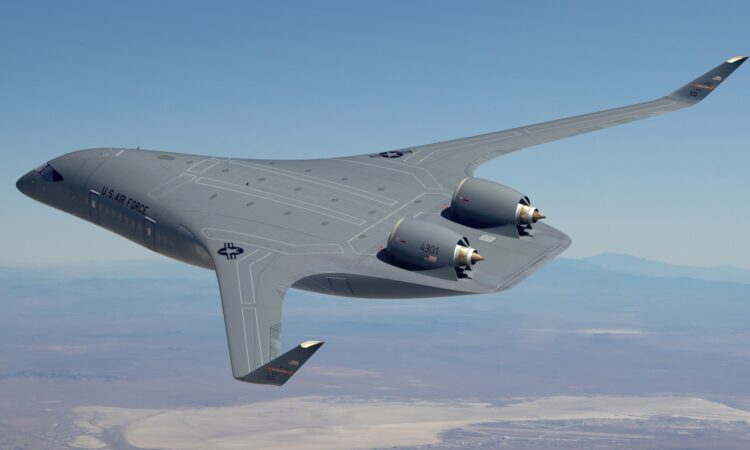
The Pacific Ocean is vast, and when it comes to planning for how to fight a war in and across it, the United States is turning to a new airframe design—one that promises more efficient flight. In an event put on by the Air And Space Forces Association on August 16, Assistant Secretary of the Air Force Ravi I Chaudhary announced the award of a contract, worth up to $230 million through 2026, for the development and production of a prototype “Blended Wing Body” airplane.
The plane was announced with concept art, showing an Air Force gray plane with a body that starts from a conventional pointy cockpit and broadens as it goes back, seamlessly sloping up into a large wing, with a pair of jets mounted on top of the plane at its rear. In the concept art, Rogers Dry Lake and the runways of Edwards Air Force Base are clearly visible, tying the new concept plane into the long history of experimental and innovative aircraft. When Chuck Yeager broke the sound barrier, he did it flying a plane out of Edwards.
“Today is a historic day in the development of airpower,” Chaudhary told the assembled crowd of press and industry spectators, in person and on Zoom. He tied the announcement of this new plane to a record-setting endurance flight from August 1923, which saw repeated mid-air refueling, allowing a plane to continuously transit from Canada to Mexico without landing in between.
Blended Wing Body design offers greater lift, as it reduces drag and expands the lifting surface of the aircraft. The B-2 flying wing bomber is a kind of extreme blended wing. While this new plane will not be designed to the same exacting and stealth demands of a long-range bomber, the hope is that it will offer long range efficiency flight, allowing it to become a valuable transport and tanker. Should oceans become battlefields, this plane, which Chaudhary referred to as the X-BWB-1, would become a valuable way for the Air Force to ensure the rest of the US military to stay in the fight, despite the long distances involved.
[Related: The Air Force wants to modernize air refueling, but it’s been a bumpy ride]
“All of you have recognized that we have entered a new era of great power competition in which the [People’s Republic of China] has come to be known as our pacing challenge, but honestly, I ain’t having it,” Chaudhary continued. “Today, we are going to set the pace by doing what we have always done. Design, build, and fly with blended wing technology.”
(While jet planes and new missiles certainly outline the parameters for a conventional war in the pacific, should one happen, nuclear weapons went unmentioned at the announcement. The US has over 5,200 nuclear warheads and China has the world’s third-largest arsenal, estimated at 410 warheads. Any conventional war between the US and China carries with it a risk of nuclear conflagration)
The last time the US fought a peer or near-peer competitor across the Pacific, the plane all used propeller engines, and operated either from aircraft carriers or fiercely contested island landing strips. Today, aircraft carriers and networks of bases are still part of the picture, but missile technology has advanced from its infancy to a durable, long-range threat.
The X-BWB-1, should it work, would provide logistical support for the US military’s planned “ACE,” or “Agile Combat Employment” strategy. Operating by these principles, the ships and planes and bases that house US forces will be distributed across the ocean, making them harder to target all at once. However, these resources can be assembled and concentrated during attacks, allowing the US to pick and choose battles as it sees fit.
“Operational energy will be the margin of victory in a near peer conflict in the Indo-Pacific,” said Chaudhary. With efficient flight, longer range, reduced radar and audio signature, and useful cargo capacity, the X-BWB-1 isn’t a weapon itself, but a tool that could make the rest of the military’s operations in this area more effective. The design also promises shorter takeoffs and landings than conventional airframes, allowing for runways on small patches of land.
The military applications of the technology took center stage at the announcement, but the commercial applications of such plane design were also brought up. The X-BWB-1 is designed to use existing jet engines, so they can be easily integrated into the commercial market. The same aerodynamic advantages that make a plane useful for military resupply could also make such a craft an efficient long-haul carrier for airlines.
“The BWB is the best first step on the path to zero carbon emissions. It offers 50 percent lower fuel burn using today’s engines and the airframe efficiency needed to support a transition to zero carbon emissions propulsion in the future,” said JetZero CEO Tom O’Leary in a release. “No other proposed aircraft comes close in terms of efficiency.”
Many branches of the military, like parts of the commercial aviation industry, have expressed a commitment towards lower-emissions operations. In the case of the US Army, this means a climate approach that emphasizes meeting existing needs and missions, but with more efficient means, rather than scaling back operations.
With significant investment from the US military and a waiting commercial market, the Blended Wing Body program could build on decades of NASA research and deliver a useful, efficient aircraft that transports soldiers as easily as passengers.
The first test flight of the X-BWB-1 is expected in 2027. Perhaps by then, the plane will have a better name.






